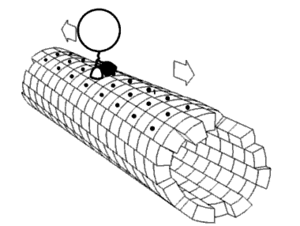
Back محرك النانو Arabic Nanomotor German Nanomotor Spanish نانوموتور Persian Nanomoteur French Motor nano ID Nanomotors Latvian/Lettish Nanomotor Dutch Nanomotor NB Nanomotor PMS
A nanomotor is a molecular or nanoscale device capable of converting energy into movement. It can typically generate forces on the order of piconewtons.[1][2][3][4]

While nanoparticles have been utilized by artists for centuries, such as in the famous Lycurgus cup, scientific research into nanotechnology did not come about until recently. In 1959, Richard Feynman gave a famous talk entitled "There's Plenty of Room at the Bottom" at the American Physical Society's conference hosted at Caltech. He went on to wage a scientific bet that no one person could design a motor smaller than 400 μm on any side.[6] The purpose of the bet (as with most scientific bets) was to inspire scientists to develop new technologies, and anyone who could develop a nanomotor could claim the $1,000 USD prize.[6] However, his purpose was thwarted by William McLellan, who fabricated a nanomotor without developing new methods. Nonetheless, Richard Feynman's speech inspired a new generation of scientists to pursue research into nanotechnology.

Nanomotors are the focus of research for their ability to overcome microfluidic dynamics present at low Reynold's numbers. Scallop Theory explains that nanomotors must break symmetry to produce motion at low Reynold's numbers. In addition, Brownian motion must be considered because particle-solvent interaction can dramatically impact the ability of a nanomotor to traverse through a liquid. This can pose a significant problem when designing new nanomotors. Current nanomotor research seeks to overcome these problems, and by doing so, can improve current microfluidic devices or give rise to new technologies.[citation needed]
Significant research has been done to overcome microfluidic dynamics at low Reynolds numbers. Now, the more pressing challenge is to overcome issues such as biocompatibility, control on directionality and availability of fuel before nanomotors can be used for theranostic applications within the body.[7]
- ^ Dreyfus, R.; Baudry, J.; Roper, M. L.; Fermigier, M.; Stone, H. A.; Bibette, J. (2005). "Microscopic artificial swimmers". Nature. 437 (7060): 862–5. Bibcode:2005Natur.437..862D. doi:10.1038/nature04090. PMID 16208366. S2CID 3025635.
- ^ Bamrungsap, S.; Phillips, J. A.; Xiong, X.; Kim, Y.; Wang, H.; Liu, H.; Hebard, A.; Tan, W. (2011). "Magnetically driven single DNA nanomotor". Small. 7 (5): 601–605. doi:10.1002/smll.201001559. PMID 21370463.
- ^ T. E. Mallouk and A. Sen, "Powering nanorobots," Scientific American, May 2009, pp. 72-77
- ^ J. Wang, "Nanomachines: Fundamental and Application", Wiley, 2013
- ^ Pal, Malay; Somalwar, Neha; Singh, Anumeha; Bhat, Ramray; Eswarappa, Sandeep; Saini, Deepak; Ghosh, Ambarish (2018). "Maneuverability of Magnetic Nanomotors Inside Living Cells". Advanced Materials. 30 (22): 1800429. doi:10.1002/adma.201800429. PMID 29635828. S2CID 205286602.
- ^ a b "Physics Term Paper -- Nanotechnology". www.geocities.ws. Retrieved 2015-10-30.
- ^ Somasundar, Ambika; Sen, Ayusman (2021). "Chemically Propelled Nano and Micromotors in the Body: Quo Vadis?". Small. 17 (5): 2007102. doi:10.1002/smll.202007102. ISSN 1613-6829. PMID 33432722. S2CID 231585127.
© MMXXIII Rich X Search. We shall prevail. All rights reserved. Rich X Search